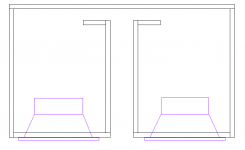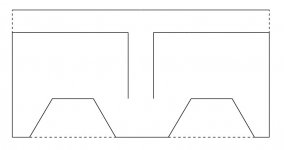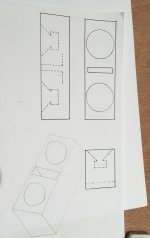Gents I am building a box for a pair of ten inch subs.
I want a ported box and have calculated the volume and size for a port which will run the full height of the box and about an inch wide. This will run the full length front to back, providing bracing at the centre of the longest panels, and out to either side in a sort of “T” shape ( when viewed from above).
My question is there any reason I cannot put the port in the centre of the box rather than to one side?
I think this will effectively create two boxes breathing through one port, any potential issues with this approach?
I want a ported box and have calculated the volume and size for a port which will run the full height of the box and about an inch wide. This will run the full length front to back, providing bracing at the centre of the longest panels, and out to either side in a sort of “T” shape ( when viewed from above).
My question is there any reason I cannot put the port in the centre of the box rather than to one side?
I think this will effectively create two boxes breathing through one port, any potential issues with this approach?
Last edited:
I can't envision how two air spaces can share a common port and remain separate. I think the compression/decompression of the air would be distributed between the two volumes evenly, making it a single shared air space. A picture would help to understand what you have in mind.
If the OP means can I build the port like in this sketch, then the answer is yes.
Because the end of the port is built in along the back wall of the box, it may behave as if it's longer than the physical length - this is due to the fact that three of the 4 walls of each end of the port continue past the end of the remaining wall. That means it may yield a tuning lower than predicted by simple box modelling tools such as WinISD - you may need to be prepared to build a prototype with a removable back so you can get access to cut the port ends shorter once you measure your actual tuning frequency.
HTH,
David.
Because the end of the port is built in along the back wall of the box, it may behave as if it's longer than the physical length - this is due to the fact that three of the 4 walls of each end of the port continue past the end of the remaining wall. That means it may yield a tuning lower than predicted by simple box modelling tools such as WinISD - you may need to be prepared to build a prototype with a removable back so you can get access to cut the port ends shorter once you measure your actual tuning frequency.
HTH,
David.
Attachments
If the OP means can I build the port like in this sketch, then the answer is yes.
Because the end of the port is built in along the back wall of the box, it may behave as if it's longer than the physical length - this is due to the fact that three of the 4 walls of each end of the port continue past the end of the remaining wall. That means it may yield a tuning lower than predicted by simple box modelling tools such as WinISD - you may need to be prepared to build a prototype with a removable back so you can get access to cut the port ends shorter once you measure your actual tuning frequency.
HTH,
David.
Spot on David, thank you.
The subs I'm using are JL audio 10w3v2s and the manual says to contact JL rather than simply just double up on box volume and port area.
They suggested 15"sq of port area and a length of 16.125 inches with a box volume of 2.25 cu.ft. net. this box is built to that spec.
I take your point about the port, is there any way apart from prototyping to model this behaviour?
Oh, I see. That is a common design. I don't know why but I envisioned this:
that's the same thing, isn't it?
Very common design for car audio subs.
Couple things to consider. This will work best when both subs are powered from a mono amp, or a mono signal if a stereo amp with each channel driving 1 sub is used. Any bass that is out of phase will be lost and you risk damaging your subs. And yes, I realize hardly any bass is recorded out of phase but the potential is there. If one sub quits working while your playing it loud you risk damaging the suspension and voice coil on both of them.
Couple things to consider. This will work best when both subs are powered from a mono amp, or a mono signal if a stereo amp with each channel driving 1 sub is used. Any bass that is out of phase will be lost and you risk damaging your subs. And yes, I realize hardly any bass is recorded out of phase but the potential is there. If one sub quits working while your playing it loud you risk damaging the suspension and voice coil on both of them.
that's the same thing, isn't it?
The one I envisioned has two port openings on the sides of the box, whereas the other design has one. More or less the same result from either but one would give different tunings.
Sorry for the delay lads, finally got some time.
Hmm, a slot loaded port with both a fairly huge baffle/side wall end correction plus another one on the backside, so maybe can be simmed in AkAbak; otherwise if using a standard vent calculator it will predict a much higher tuning than actual.
This should get you closer [B: high pass filters], but AFAIK will still be tuned too high since I've no clue what the end correction would other than the standard slot port one [K = 2.227] may be a 'close enough' compromise: http://users.cms.caltech.edu/~ps/All.pdf
https://www.diyaudio.com/forums/att...-dayton-port-length-effective-port-length-jpg
Another good one for a bjorno advanced 'tutorial'............
GM
Thanks BSE, it will be powered by a Soundstream monoblock so no worries on that account.
My chief worry, before David raised his point, was that the two subs might be pushing air "against each other" due to the 180 degree port entry orientation.
Nah, that'll be fine.
If you think about it, as long as each each driver moves in the same direction, they each create the same pressure change inside their own chamber, and thus the same activation of the air mass in the port.
If you screwed up your wiring and had the polarity of one driver backwards, then you'd have a problem all right, but barring that you're good to go.
Re the calculation of the port, if you want to do a bit of number crunching you can recalculate port length with a different end correction value as alluded to by GM, but I don't know how well it would account for the back part of the vent being split with most of the port being single, hence prototyping will probably still be needed.
I don't know if a lag would be considered distortion, but there is one song that has a serious lag on my system around tuning. I can live with it. I'm pretty sure the error is't in the recording but haven't verified this yet.
I’m half tempted to build a sealed box for these subs too as a comparison between sealed and ported, one in each.
I’ve always gone for sealed boxes historically on no more than belief really, fancied trying out a sealed box to see if the issues you mention would bother me.
My question about distortion was just that whilst I understand that pushing a driver past xmax results in cone distortion, I just wanted to check if there was any other aspect of cabinet design which did also.
Yeah I think it is a good idea to try both. I would like to hear what you prefer and why.
I was a sealed guy my whole life. Now I don't think I will ever go back. I like a very wide variety of music and I have to have a system plays below 30hz loudly. I think most sealed will drop off before that. It all depends on what you listen to. The thing I've learned after all these years - everything is a trade off. My biggest complaint about my system is that it isn't loud enough. It takes a lot of power to play the ultra low frequencies and when the box is tuned low, it makes the 50hz to 80hz sound a bit quiet for my taste. BUT all the notes play at a volume that is PERCEIVED as equal and that is what matters to me, even though the lower frequencies are actually being played louder. People say that sealed is better because it gives a FLAT response, which is utterly dreadful to me. And I don't believe they actually are flat down to 25Hz. Boxes tuned to 40Hz are very loud in my car but so unbalanced it is a nightmare to listen to.
I was a sealed guy my whole life. Now I don't think I will ever go back. I like a very wide variety of music and I have to have a system plays below 30hz loudly. I think most sealed will drop off before that. It all depends on what you listen to. The thing I've learned after all these years - everything is a trade off. My biggest complaint about my system is that it isn't loud enough. It takes a lot of power to play the ultra low frequencies and when the box is tuned low, it makes the 50hz to 80hz sound a bit quiet for my taste. BUT all the notes play at a volume that is PERCEIVED as equal and that is what matters to me, even though the lower frequencies are actually being played louder. People say that sealed is better because it gives a FLAT response, which is utterly dreadful to me. And I don't believe they actually are flat down to 25Hz. Boxes tuned to 40Hz are very loud in my car but so unbalanced it is a nightmare to listen to.
- Status
- This old topic is closed. If you want to reopen this topic, contact a moderator using the "Report Post" button.
- Home
- Loudspeakers
- Subwoofers
- Port placement for a twin subwoofer box?


